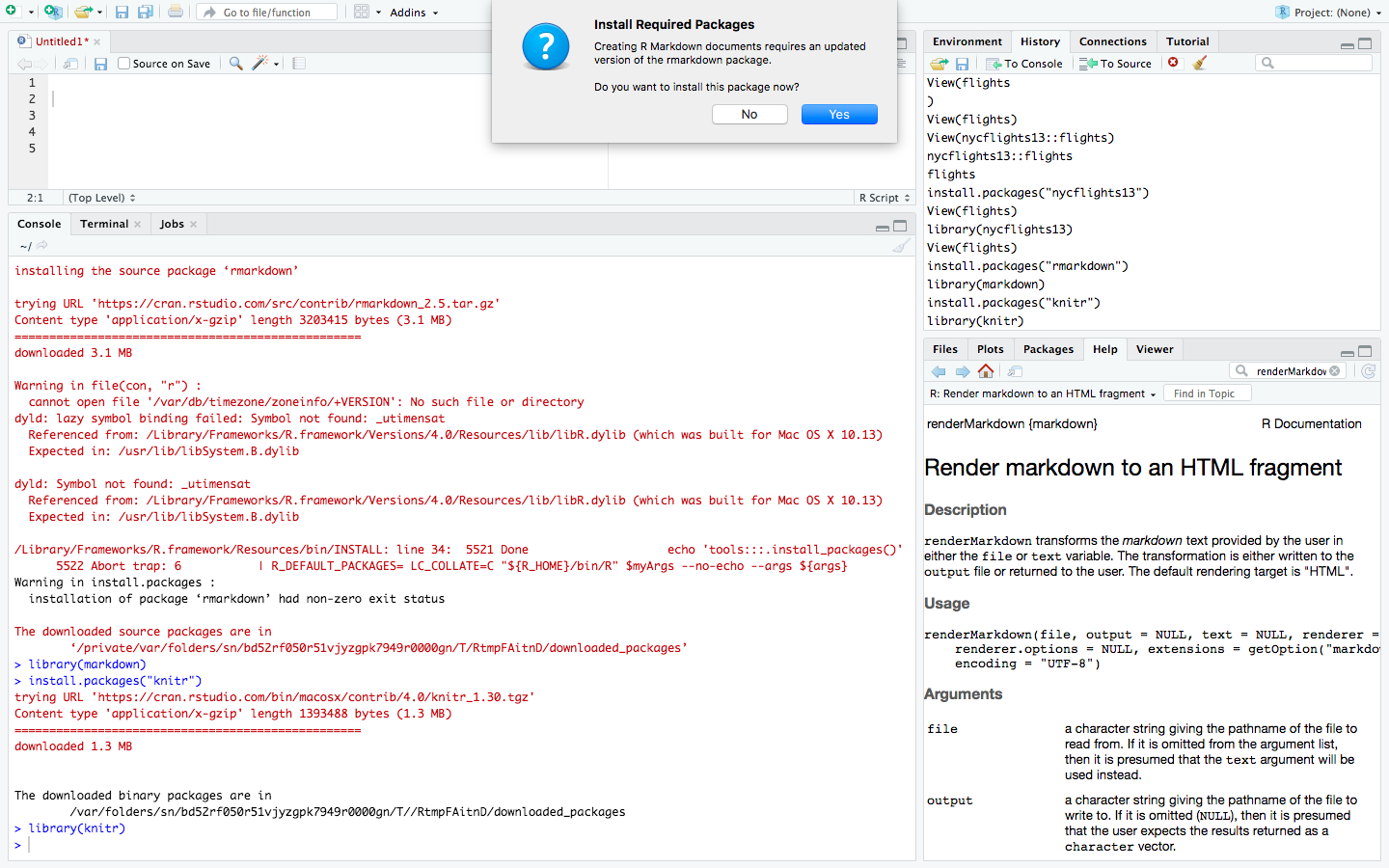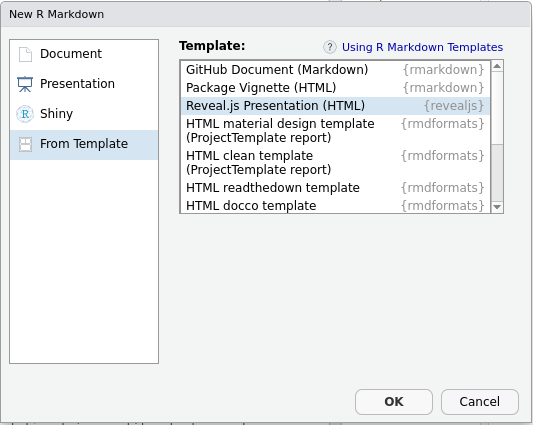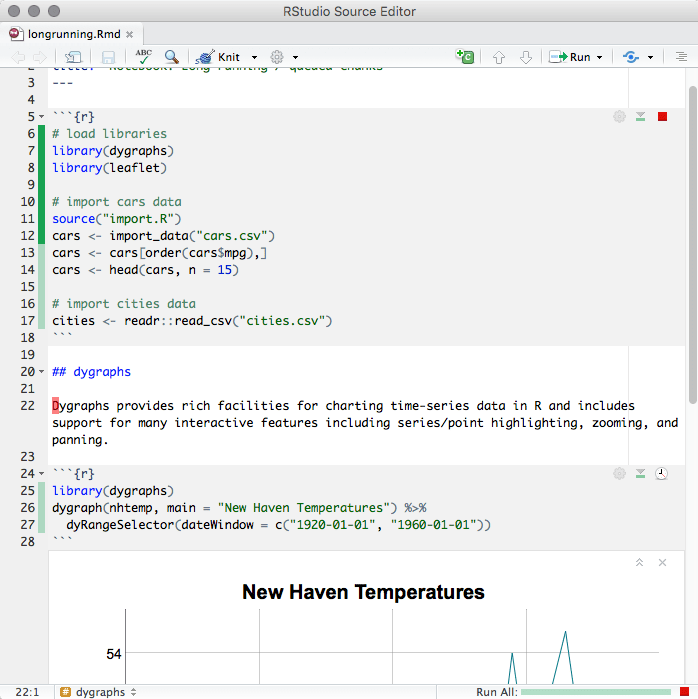

- #R markdown for mac how to#
- #R markdown for mac update#
- #R markdown for mac full#
- #R markdown for mac software#
- #R markdown for mac code#
echo = FALSE to not print the chunk’s R source code in the output document. The curly brackets can include other options too, written as tag=value, such as:. Note that if you name your chunks, you should ALWAYS use unique names or else R will complain when you try to render. 
 After the r you can optionally write a chunk “name” – these are not necessary but can help you organise your work. They start with ‘r’ to indicate that the language name within the chunk is R. These ‘chunks’ will appear to have a slightly different background colour from the narrative part of the document.Įach chunk is opened with a line that starts with three back-ticks, and curly brackets that contain parameters for the chunk ( : There may be many code chunks, so they can help you organize your R code into parts, perhaps interspersed with text. This is where you may load packages, import data, and perform the actual data management and visualisation. Sections of the script that are dedicated to running R code are called “chunks”. For more details, see the handbook pages on R on network drives and. If you use Git (much recommended!), this will be familiar. Note that use of setwd() in R Markdown scripts is not recommended – it only applies to the code chunk that it is written in.īecause R Markdown can run into pandoc issues when running on a shared network drive, it is recommended that your folder is on your local machine, e.g. in a project within ‘My Documents’. For instance, to import a file called “data.csv” from within the projectX folder, the code would be import(here(“data.csv”)). The here package sets the working directory to the root folder of the R project and is explained in detail in the R projects and Import and export pages of this handbook.
After the r you can optionally write a chunk “name” – these are not necessary but can help you organise your work. They start with ‘r’ to indicate that the language name within the chunk is R. These ‘chunks’ will appear to have a slightly different background colour from the narrative part of the document.Įach chunk is opened with a line that starts with three back-ticks, and curly brackets that contain parameters for the chunk ( : There may be many code chunks, so they can help you organize your R code into parts, perhaps interspersed with text. This is where you may load packages, import data, and perform the actual data management and visualisation. Sections of the script that are dedicated to running R code are called “chunks”. For more details, see the handbook pages on R on network drives and. If you use Git (much recommended!), this will be familiar. Note that use of setwd() in R Markdown scripts is not recommended – it only applies to the code chunk that it is written in.īecause R Markdown can run into pandoc issues when running on a shared network drive, it is recommended that your folder is on your local machine, e.g. in a project within ‘My Documents’. For instance, to import a file called “data.csv” from within the projectX folder, the code would be import(here(“data.csv”)). The here package sets the working directory to the root folder of the R project and is explained in detail in the R projects and Import and export pages of this handbook. #R markdown for mac full#
To refer to files elsewhere, you will either need to use the full file path or use the here package. For instance, if the R project is within ~/Documents/projectX and the Rmd file itself is in a subfolder ~/Documents/projectX/markdownfiles/markdown.Rmd, the code read.csv(“data.csv”) within the markdown will look for a csv file in the markdownfiles folder, and not the root project folder where scripts within projects would normally automatically look. The working directory of a markdown file is wherever the Rmd file itself is saved. md file is then processed by pandoc to create the finished product: a Microsoft Word document, HTML file, powerpoint document, pdf, etc. md (markdown) file which includes the R code and its rendered output. Rmd file to knitr, which executes the R code chunks and creates a new. In sum, the process that happens in the background (you do not need to know all these steps!) involves feeding the.
#R markdown for mac software#
It is a software separate from R but is installed automatically with RStudio.
Pandoc: Finally, pandoc actually convert the output into word/pdf/powerpoint etc. This is how tables and graphs are included alongside the text. knitr: This R package will read the code chunks, execute it, and ‘knit’ it back into the document. It’s focus is converting the markdown (text) syntax, so we also need… rmarkdown - the package: This is used by R to render the. R Markdown: is a variation on markdown that is specific to R - it allows you to write a document using markdown to produce text and to embed R code and display their outputs. Files written in Markdown have a ‘.md’ extension. Markdown is a “language” that allows you to write a document using plain text, that can be converted to html and other formats. To explain some of the concepts and packages involved: Of note, the R4Epis project has developed template R Markdown scripts for common outbreaks and surveys scenarios encountered at MSF project locations. #R markdown for mac how to#
The page Dashboards with R Markdown explains how to format a R Markdown report as a dashboard. The page Organizing routine reports demonstrates how to routinize your report production with auto-generated time-stamped folders. Other pages in this handbook expand on this topic: #R markdown for mac update#
Such documents can be produced to update on a routine basis (e.g. daily surveillance reports) and/or run on subsets of data (e.g. reports for each jurisdiction). You can create an entire formatted document, including narrative text (can be dynamic to change based on your data), tables, figures, bullets/numbers, bibliographies, etc.

It can generate static or interactive outputs, in Word, pdf, html, powerpoint, and other formats.Īn R Markdown script intersperces R code and text such that the script actually becomes your output document. R Markdown is a widely-used tool for creating automated, reproducible, and share-worthy outputs, such as reports.
46 Version control and collaboration with Git and Github. 33 Demographic pyramids and Likert-scales. 19 Univariate and multivariable regression.








 0 kommentar(er)
0 kommentar(er)
